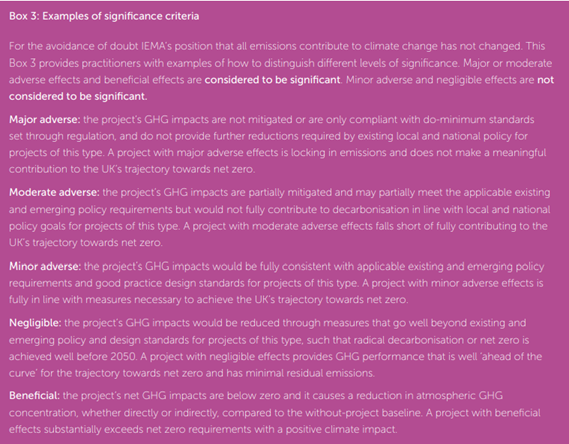In recent years, climate change has rapidly climbed the political and public agenda; the UK Government has committed to a net zero carbon target for 2050; and 350 UK local authorities have declared climate emergencies, set carbon zero targets or carbon budgets, and are developing climate policies and action plans to guide development in the future[1].
The completion of thorough and robust GHG and climate change assessments for large (EIA) development projects has therefore become more and more valuable, and the desire from planning decision makers to see such assessments for smaller schemes is also becoming more common.
In March 2022, the Institute of Environmental Management and Assessment (IEMA) released the 2nd version of its guidance on the assessing GHG emissions and evaluating their significance. This provides IEA practitioners with new tools with which to assess the significance of greenhouse gas (GHG) emissions from developments.
The Environmental Impact Assessment (EIA) Regulations 2017 requires that all EIAs provide “A description of the factors…likely to be significantly affected by the development” and lists “climate (for example greenhouse gases…)” as one such consideration. However, there is no formal or statutory approach or guidance on the assessment GHG emissions for plans or projects. EIA Practitioners have until now relied on the first version of the IEMA guidance, published in 2017, when producing GHG and climate change assessments.
What Has Changed?
The guidance broadly mirrors the overall structure of the 1st version and covers planning the scope of a GHG assessment, methodologies for estimating a development’s GHG footprint and determining baseline emissions. The subsequent framework for approaching mitigation follows the avoid, reduce and offset hierarchy for GHG mitigation.
The key addition to the guidance is a methodology for determining the significance of effects, which aligns with the standard approach within EIA to describe effects on a scale of negligible - minor – moderate - major. The 2017 version advised a precautionary approach where all additional GHG emissions were considered significant, but this approach limited the ability to demonstrate when a development’s GHG emissions were actually significant and, crucially, when they have been appropriately avoided or reduced.
The new approach to determining the significance of effects is based on two steps:
Step 1: establish the context of a project’s GHG emissions (usually by comparison to relevant established GHG budgets or targets); and
Step 2: test the consistency of the project with national, regional and local policies designed to limit GHG emissions and meet the UK’s net zero target, and demonstrate the robustness, timeliness and efficacy of mitigation measures proposed to avoid, reduce and compensate GHG emissions.
This approach, in contextualising emissions and then rigorously testing policy compliance and mitigation against best practice, aligns well with the approach AQC have taken to the completion of GHG assessments for a large number of developments and commercial clients in recent years.
The updated IEMA guidance advises that following completion of Steps 1 and 2, the overall significance of effects can then be determined using professional judgement and applying the principles described in Box 3 of the guidance, shown below.

What Do the Changes Mean for Development Proposals?
The changes to the determination of significant effects means that it is easier for planners and decision makers to identify when a development meets the requirements of policy and good practice mitigation and can be considered ‘not significant’, or even provide beneficial GHG effects and can be given suitable weight in decision making.
It also allows clearer identification of schemes which may contribute additional GHG emissions that cannot be fully mitigated and which are considered significant. These may then be addressed in the planning balance or subject to further commitments to offset excess emissions.
The guidance puts a clear focus on demonstrating policy compliance and ensuring a project’s mitigation meets best practice, and incentivises designers and developers to go beyond policy minimums and mitigation best practice. Developments that are able to demonstrate they go beyond the norm or minimum can be rewarded with a lower level of significance.
How Can AQC Support You?
AQC offer a range of services to support planners and developers, businesses, regulators and policy makers with GHG footprints, climate change assessments, net zero carbon plans and strategies, and carbon and climate change policy. Please visit www.aqconsultants.co.uk for more details.
View all news